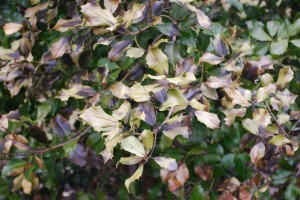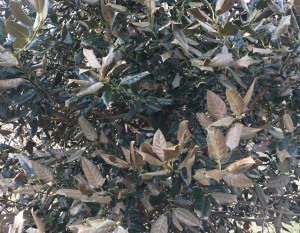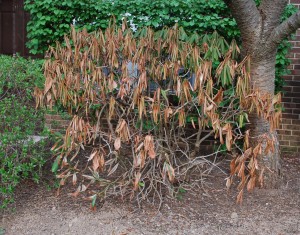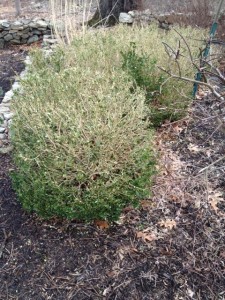Despite a winter that tormented us, most plants did pretty well in the snow. While there was plenty of mechanical damage from several heavy snow storms, the snow accumulation actually protected many plants. Snow cover helped to prevent winter desiccation, particularly in plants lucky enough to have been buried, like turfgrass. It also kept the ground in many locations from a hard freeze, which helped provide much needed moisture to the landscape.
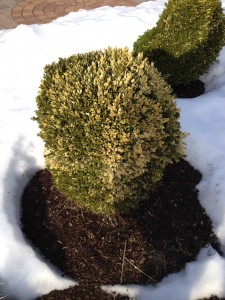
Winter damage of boxwood. Everything causes boxwood to turn brown! Photo: Richard Buckley, Rutgers PDL
Not all plants fared so well. In my travels, I am starting to see leaf scorch symptoms common to winter injury on many broadleaved evergreens. As usual, shallow rooted plants such as azalea, rhododendron, holly, boxwood, mountain laurel, or those at their northern limits for winter hardiness, like Magnolia grandiflora and Acuba japonica, suffered the most.
Winter injury occurs on dry, windy, warm, or sunny winter days when the ground is frozen. Winter injury is indeed a form of drought stress. Evergreens continue to transpire in the winter (they do have leaves), so when the demand for moisture increases, they are unable to move sufficient amounts of water from cold and frozen soils to replace the water lost from the leaves. Leaves subsequently wilt, curl and droop, then brown from the tips and margins, which gives the leaves a scorched appearance, not that different from what we see during summer heat and drought periods.
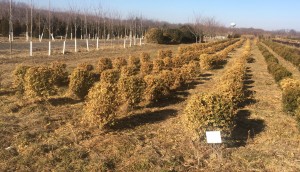
Winter damage is more severe in open and exposed locations. Winter helps decrease the surplus population of boxwood. Photo: Richard Buckley, Rutgers PDL
Plants in open locations (wind), those with southern (heat) or northeastern (wind) exposures, those in heat sink areas, or near reflective surfaces (walls, fences, roads, sidewalks, etc.) exhibit the most damage. Warm temperatures and wind not only increase transpiration demands, but can desiccate tissues outright. Furthermore, damage from direct solar radiation is not uncommon.
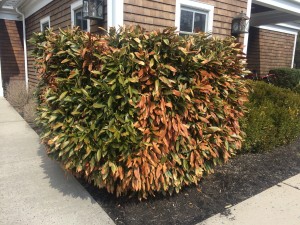
Winter injury of cherrylaurel. Damage is more severe in a heat sink. Photo: Richard Buckley, Rutgers PDL
Be aware that winter damage can appear anytime in the spring as plants begin to emerge from the winter dormant period and move into the spring growth phase. Again, increasing transpiration demands, this time due to new growth, as well as increasing temperatures and even sometimes a lack of soil moisture cause injured tissues to fail. It is always difficult to inform one’s client that their shrub burned up in the winter, when it is 75oF in May! Must have been something you did!
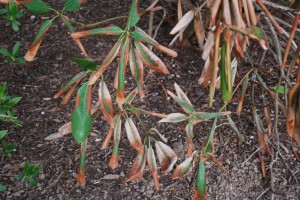
Winter injury on rhododendron occurs in May in response to increasing transpiration demands. Photo: Richard Buckley, Rutgers PDL
Don’t assume that what we are seeing now is the extent of the damage for this season. I am watching the conifers closely. In fact, I would expect to see random dieback and nondescript scorching in arborvitae, juniper, Douglas-fir, and spruce going forward. Expect to see a fair amount of salt damage as well. And one more thing, when deer get hungry in the winter, they’ll eat anything.
Even boxwood! Bwa ha ha haa ha haaaaa!
